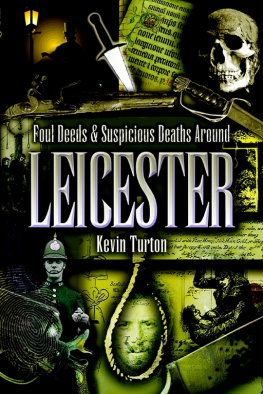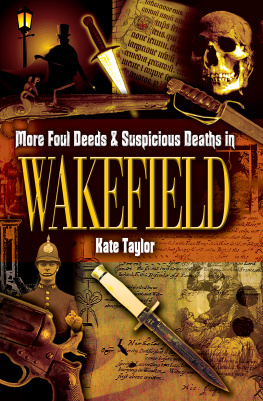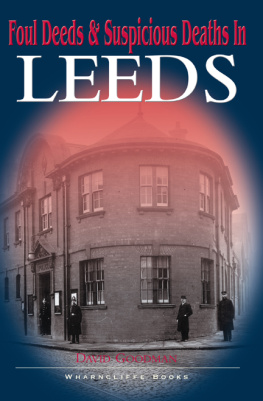
First Published in 2002 by
Wharncliffe Books
an imprint of
Pen and Sword Books Limited,
47 Church Street, Barnsley,
South Yorkshire. S70 2AS
Copyright Steve Greenhalgh
For up-to-date information on other titles produced under the
Wharncliffe imprint, please telephone or write to:
Wharncliffe Books
FREEPOST
47 Church Street
Barnsley
South Yorkshire S70 2BR
Telephone (24 hours): 01226 - 734555
ISBN: 1-903425-18-2
PRINT ISBN: 9781903425183
PDF ISBN: 9781783037872
EPUB ISBN: 9781783037896
PRC ISBN: 9781783037889
All rights reserved. No part of this publication may be
reproduced, stored in a retrieval system, or transmitted, in
any form or by any means, electronic, mechanical,
photocopying, recording or otherwise, without the prior
permission in writing of the publishers.
This book is sold subject to the condition that it shall not,
by way of trade or otherwise, be lent, resold, hired out or
otherwise circulated without the publishers prior consent in
any form of binding or cover other than that in which it is
published and without a similar condition including this
condition being imposed on the subsequent purchaser.
A CIP catalogue record of this book is available from the
British Library
Cover illustration:Scene at a Victorian murder
Printed in the United Kingdom by
CPI UK
Contents
Introduction
Murder, like death and taxes, is always with us. It haunts the pages of newspapers, library records and our lifetime memories. Terrible as they undoubtedly are, murders nevertheless provide an invaluable insight into the life and times of our forefathers whilst detailing the demise of some of the best and worst of them.
The following collection is an entirely local one. Not concerned with Jack the Ripper as done to death as any of his victims nor even the poor mans Yorkshire variety, these are detailed accounts of murders, foul deeds and suspicious deaths committed either on our doorstep or forever associated with the Blackburn and Hyndburn areas. Encompassing the late Victorian period until 1929, they are equally as gruesome and instructive as the more well-known cases which inhabit the pages of any number of true crime anthologies. Some were in fact reported nationally in their time but others, equally deserving of attention, mouldered in the records of the past, neglected and forgotten.
Why resurrect these events now? Because, for one thing, they are an important part of our history. We can learn from even the misdeeds of members of past generations whilst marvelling at the often poor, squalid lives they endured if they were unlucky enough to be ordinary working-class.
The appalling social conditions that prevailed during the period of most of these crimes inevitably coloured the stories of the men, women and children who played their part in them. Those stories, however, are worthy of being recounted in the new millennium.
In conclusion, I am reminded of an old truth that suddenly comes to mind:
He that goes forth with one eye on the past goes forth with one eye closed. He that goes forth ignorant of the past goes forth blind!
Acknowledgements
I wish to thank the following for their invaluable help and assistance in the production of this book.
~ Helen Barrett and Catherine Duckworth of the Accrington Local Studies Library.
~ Diane Rushton and staff of the
Blackburn Local Studies Library.
~ The administrative staff of Accrington and Blackburn cemeteries.
~ Alan J Bytheway, true crime writer, of Ilkley, Yorkshire.
~ Alan Parkin.
~ The meteorological office.
~ Accrington Observer and Times, Lancashire Evening Telegraph and the Blackburn Times.
~ Kathryn, my wife, for good advice, ongoing enthusiasm, computer skills and regular meals.
~ Emma Kate, my daughter, for vital research when needed and constant support.
I should also like to mention specifically the principal victims of the crimes detailed in the following pages, namely:
Alice Rhodes Wildman
Alice Beetham
Henrietta Leaver
Sarah Coates
Emily Holland
Deborah ODowd
Frederick Cornwallis Benwell
Walter Neilson
Eleanor Pilkington and Alice Barnes
whose lives were unduly and unlawfully cut short by the malicious, the mad and the downright evil. Though the victims stories deserve to be remembered and retold, may they now and forever Rest in Peace.
Dedication
THIS ONE TIME FOR
James H, Mary and Harold;
Jack, Phyllis and Ethel May;
Kathryn and Emma Kate.
The will therein lieth
which dieth not
Edgar Allan Poe
Chapter 1
The Victoria Street Horror 1923
W hat might be worse than murder? What foul and devilish deed could outrage the soul more than the taking of a life? How could anyone confound and repudiate their own humanity to such an extent? In the month of September 1923 the residents of Greater Accrington were left to contemplate the answers to those ominous questions as the Victoria Street horror unfolded in their midst.
John Whalley was thirty-two years old, well-built, sandy haired and good-looking. On the surface at least, a good catch for any woman. But John Whalley had his drawbacks not the least of which were a violent temper and a worsening over-fondness for liquor. Still, initially at least, he must have seemed everything she had wanted to Maud Wildman, an attractive and pretty young woman of the town. Indeed the couple got married on Easter Saturday, 1921.
Maud was a widow when she got hitched to John Whalley. Her first husband, Joseph Wildman, had died in Scotland on munitions back in November 1918. Their daughter, Agnes Rhodes Wildman, was just a few months old at the time of her unfortunate fathers death too young to miss or remember him. She was less than three years old when her mother tied the knot with her future stepfather, the couple having known each other since they were children, and the family moved in with Whalleys parents at 15 Claret Street, Accrington.

John Whalley. Accrington Observer and Times

15 Claret Street, Accrington. John Whalley, Maud and Agnes lived there with Whalleys parents before moving to Miss Horburys. The author
Most young couples starting out on married life in one of the parental households soon come to regret the arrangement. Awkward, disruptive and unsatisfactory in every respect, it was only tolerated out of necessity. Perhaps this state of affairs contributed to the problems experienced by John Whalley, his new wife and stepdaughter, for Maud soon discovered her husband was a bad tempered individual or, as he was described then, a man of considerable passion at times! She also quickly became aware that he treated Agnes and herself badly which must have alarmed and disappointed her, destroying all her earlier hopes and expectations of a happy new life for her daughter and herself.
In September 1922, probably in a last attempt to mend matters between them, John Whalley, Maud and young Agnes moved to the house of Miss Sarah Ann Horbury at 12 Victoria Street, Accrington, as lodgers. Though their landlady said later that she had had no trouble with her tenants for the best part of a year, relations between Whalley and Maud had clearly been deteriorating during that time. Rows and arguments had become the norm and John Whalleys belligerence and bad treatment of his family increased along with his consumption of best bitter.
Next page















